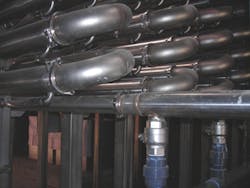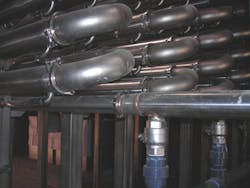High-throughput filtration membranes are at the heart of an extremely compact wastewater treatment plant on Sant”Erasmo island in the Venice lagoon. Engineered by CP Srl, the sidestream bioreactor configuration employed is one of around 100 in the Venice area alone employing advanced filtering technology from PCI Membranes, a business unit of ITT Flow Control.
The membrane system is assembled using straight sections and u-bend PCI Membranes modules, allowing the complete filtration system to sit on a very small footprint.
Image courtesy of PCI MembranesVenice”s wastewater treatment network is highly distributed, with many small processing plants handling groups of houses or buildings, or single large installations such as hotels. The plant on Sant”Erasmo is on an even larger scale; it processes all of the wastewater treatment for the population of the mainly agricultural island – which produces fruit and vegetables for the city”s population – as well as wastewater from the densely populated island of Burano.??
For this application, which handles up to 1,000 cubic meters a day or the equivalent wastewater output of around 4,000 people, CP uses PCI Membranes” largest stainless steel tubular system, the A37 module. Housing 37 tubular polymeric membranes within a 100 mm diameter, 3.66 m-long stainless steel housing, each A37 module provides a cross-flow filtration surface area of 5 square meters. As the membranes will operate with a pressure of up to 7 bar (102 PSI), multiple modules can be connected in series and driven by pumps to achieve high throughputs.??
The system for Sant”Erasmo is a membrane bioreactor – a wastewater treatment system combining biological oxidation with activated sludge and a filtration system. An underground basin handles the sedimentation, de-nitrification and nitrification treatment stages, while the pressurized sidestream filtering system separates the solid and liquid phases. The particular filtration configuration designed for this application is a pumped system with two parallel processing lines constructed using 45 tubular A37 modules each, providing some 450 square meters of filtration area in total. These two processing lines are assembled with u-bend components to form compact processing stacks. The approach allows the complete filtration system to sit on a footprint of less than 5×5 m, with a height of only 2.8 m.??
In operation, wastewater flows into an activated sludge biological treatment basin or bioreactor for breakdown of the organic material. It is cycled through the ultrafiltration plant to remove the sludge and high molecular weight solids. These solids are sent back to the bioreactor until they can no longer be degraded, and are periodically removed for a final de-watering phase and then disposal. Separated particle-free effluent is ozone polished before being re-used for irrigation.??



